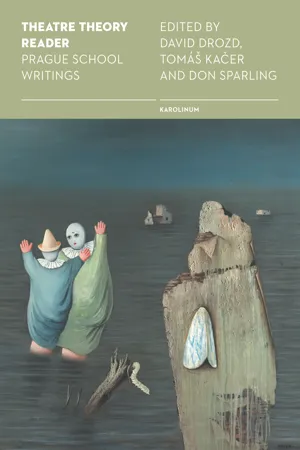
- English
- ePUB (mobile friendly)
- Available on iOS & Android
eBook - ePub
About this book
The Theatre Theory Reader provides the first comprehensive and critical anthology of texts reflecting on the development of the theater theory of the Prague School—or Prague Linguistic Circle—beginning with early twentieth-century composer and aesthetician Otakar Zich. The majority of the thirty-eight texts date from the 1930s and early 1940s, the period when the Prague Linguistic Circle was most active as both a theoretical laboratory and a focal point for scholars, artists, and intellectuals. A substantial afterword places these writings in context, describing the emergence of the Prague School in an effort to promote a deeper understanding of its texts. Organized thematically and structurally rather than chronologically, the Theatre Theory Reader explores issues and themes in the study of the theater as an art form and as artistic practice. Just as the Prague School theorists viewed theory as a toolbox of approaches to theater analysis, this anthology should be considered a toolbox of analytic possibilities.
Frequently asked questions
Yes, you can cancel anytime from the Subscription tab in your account settings on the Perlego website. Your subscription will stay active until the end of your current billing period. Learn how to cancel your subscription.
No, books cannot be downloaded as external files, such as PDFs, for use outside of Perlego. However, you can download books within the Perlego app for offline reading on mobile or tablet. Learn more here.
Perlego offers two plans: Essential and Complete
- Essential is ideal for learners and professionals who enjoy exploring a wide range of subjects. Access the Essential Library with 800,000+ trusted titles and best-sellers across business, personal growth, and the humanities. Includes unlimited reading time and Standard Read Aloud voice.
- Complete: Perfect for advanced learners and researchers needing full, unrestricted access. Unlock 1.4M+ books across hundreds of subjects, including academic and specialized titles. The Complete Plan also includes advanced features like Premium Read Aloud and Research Assistant.
We are an online textbook subscription service, where you can get access to an entire online library for less than the price of a single book per month. With over 1 million books across 1000+ topics, we’ve got you covered! Learn more here.
Look out for the read-aloud symbol on your next book to see if you can listen to it. The read-aloud tool reads text aloud for you, highlighting the text as it is being read. You can pause it, speed it up and slow it down. Learn more here.
Yes! You can use the Perlego app on both iOS or Android devices to read anytime, anywhere — even offline. Perfect for commutes or when you’re on the go.
Please note we cannot support devices running on iOS 13 and Android 7 or earlier. Learn more about using the app.
Please note we cannot support devices running on iOS 13 and Android 7 or earlier. Learn more about using the app.
Yes, you can access Theatre Theory Reader by David Drozd in PDF and/or ePUB format, as well as other popular books in Mezzi di comunicazione e arti performative & Arti performative. We have over one million books available in our catalogue for you to explore.
Information
PRAGUE SCHOOL THEATRE THEORY AND ITS CONTEXTS (AFTERWORD)
BY PAVEL DRÁBEK WITH MARTIN BERNÁTEK, ANDREA JOCHMANOVÁ AND EVA ŠLAISOVÁ
“There is only one thing you must not forget – these twenty years were immensely beautiful. Remind everyone of how much work we managed to do.”
The poet Jaroslav Seifert, bidding farewell to Roman Jakobson in Prague in April 1939 (cited in Toman 1995: 2)
THE PRAGUE LINGUISTIC CIRCLE AND ITS MISSION1
The Prague Linguistic Circle (PLC) was established in 1926 with the vision that scholarship should become engaged in the practical problems of the modern world. This diverse community of intellectuals, artists and practitioners exercised what would later come to be known as “critical theory” and integrated practice and theory organically.
In 1935, the Prague Linguistic Circle (PLC) launched its journal Slovo a slovesnost (The Word and Verbal Art); in the introduction to the first issue (Havránek et al. 1935), the founding members Bohuslav Havránek (1893–1978), Roman Jakobson (1896–1982), Vilém Mathesius (1882–1945), Jan Mukařovský (1891–1975) and Bohumil Trnka (1895–1984) outlined the programme of the journal – almost a manifesto of their initiative. It is worth citing at length:
The scholarship of today requires the detailed development of a terminology that would be both accurate and flexible, whose terms would have an internationally uniform meaning. The functions of language keep differentiating more and more. It suffices, for instance, to consider how many new tasks are required of language in today’s journalism, which is constantly developing and continues to grow in importance: the very technology of newspapers, the problem of rapid and easy reading, issues of having an effective impact on the reader and other specific purposes. With the development of technical means language has found its way into novel, unprecedented situations: in radio, we have the word as a mere sound devoid of visual phenomena; in sound film, there are undreamed-of possibilities for combining speech and visual impressions. The language of fiction departs more than ever before from a unified canon: linguistic criticism must not employ one single standard to assess a Surrealist poem gravitating towards a dream, the language of James Joyce or Vladislav Vančura, in which several layers are interwoven polyphonically, Louis-Ferdinand Céline’s or Jaroslav Hašek’s rich use of colloquial speech, or the prose of classical realism, sticking anxiously to the generally valid literary norm. By no means the last source of new tasks is the astonishingly rich translation activity; it is enough to look at the statistics for translations in the areas of fiction, journalism and specialized literature to realize the great linguistic influence translations have. […]
Our scholarship must not look on passively when it comes to solving the current tasks outlined above. Once and for all Czech linguistics, too, must overcome its temporary dissociation from present-day culture and enter directly into its service; it must take the initiative in dealing with contemporary issues of linguistic culture. However, the fragmented efforts of individual philologists will not do; the urgency of the tasks calls for a collective, organized coordination of scholarly forces. Nor will the separate activity of philologists themselves suffice; what is needed is the close collaboration of linguists with teachers and lawyers, with philosophers and psychologists, with psychiatrists and phoniatrists, with historians and theorists of literature and the arts generally, with specialists in sociology, history, geography and folklore. But what is needed above all is cooperation with the practitioners of linguistic culture, with writers and translators, with theatre, film and radio artists and technicians, with educational specialists well as with administrative and technical professionals who have practical experience in questions of terminology.
This is the programme and the path for Slovo a slovesnost. (Havránek 1935: 3–4)
The programme outlined above makes several crucial statements. At its centre is modern language and its uses, and it is through a critical study of language that modern reality is reflected in its novel complexities and the innovations of the Modernist age.
Slovo a slovesnost became the main platform of the PLC in the Czech language. In addition a number of significant articles also appeared in German-language periodicals published in Czechoslovakia, in particular the daily Prager Presse and the journals Slavische Rundschau, Germanoslavica and Prager Rundschau. Publishing in German played a crucial role in making the PLC’s research findings available to an international readership. The Prager Presse, for instance, had over 2,000 subscribers outside Czechoslovakia in 1937 and was also on sale publicly alongside the rest of the daily press (Bernátek 2016: 10).2
The programme formulated by Havránek not only clarifies the concept of language and linguistics within which the writers operate but also sees scholarship and intellectual efforts as a social and cultural need – a public issue that needs addressing. Scholarship is an instrument of public activity and engaging in it is what later became known as critical theory in action. This appeal for active, engaged and committed public intellectuals was a crucial contribution of one of the PLC founders, the linguist and pioneer of Czech English studies Vilém Mathesius. In his 1925 booklet Cultural Activism: English Parallels to Czech Life (Mathesius 1925), Mathesius articulated his belief “in rationally organized work and in the active involvement of intellectuals in public affairs” (Toman 1995: 3). This impulse harmonized with the activism of the Russian intellectuals who joined in the initiative and their Cubo-Futurist leanings. For scholarship to be a valid part of the society it needs to be practised hand in hand with public servants, artists, technicians and administrators – the very practitioners who come into immediate contact with the active life of the society and its problems. In this sense, for research and scholarship to be effective it has to be embodied and realized in practice; this gives it full momentum and the power to influence public wellbeing. This approach counters the negatives of the monastic tradition of the academia that secludes itself from everyday life and assumes a faux elitist stance of knowledge and superiority. Prague School intellectuals practised their scholarship in direct contact with cultural workers, not only by contributing to theatre programme notes and to newspapers with analyses of new work but also by being practitioners themselves. For instance, Jindřich Honzl (1894–1953), Jiří Frejka (1904–1952) and Emil František Burian (1904–1959) were members of the PLC as well as being the leading Czech avant-garde stage directors of the day. Their participation was far from symbolic: when the Czech universities were closed by the Nazi occupiers on 17 November 1939, Burian’s acting school, which operated at his Theatre D 41, organized public lectures that in many ways substituted for academic activities (see Drozd 2016: 100, n. 25). Of great significance was the active participation of three leading Czech intellectuals and artists: the critic František Xaver Šalda (1867–1937), the writer and dramaturge Karel Čapek (1890–1938) and the avant-garde poet Vítězslav Nezval (1900–1958) were all influential public personalities and their contribution to the PLC in the 1930s played an important role in bridging academic activities and the public sphere.
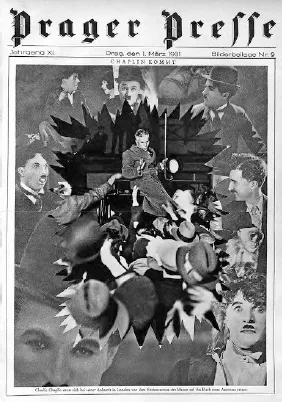
Fig. 1: Cover of the Prager Presse, a daily newspaper founded in March 1921 by the news section of the Czechoslovak Ministry of Foreign Affairs. In 1922, the state-owned publishing house Orbis became its publisher. The journal promoted the official policies of the Czechoslovak state (it continued to be supported financially by the Ministry of Foreign Affairs). The Prager Presse ceased publication in the wake of the Munich Agreement of September 1938, which marked the collapse of the political conception of the Czechoslovak state promoted by President Tomáš Garrique Masaryk and his successor as second Czechoslovak President, Edvard Beneš. The last issue of the Prager Presse appeared on 31 December 1938.

Fig. 2: Cover of Slovo a slovesnost (design Jiří Kan), published by the Prague Linguistic Circle from 1935. This issue dates from 20 September 1941. On the cover there is a propaganda piece entitled “The Reich is Winning on All Fronts in Europe”; this appeared just as the armies of the Third Reich were poised to launch the disastrous Battle of Moscow. The issue includes, among other articles, Jiří Veltruský’s “Dramatic Text as a Component of Theatre”.
The range of topics and disciplines covered by Prague School theory is indicative of its energy as well as its reach – from performance and theatre theory and film theory, through theatre phenomenology, theatre semiotics, drama analysis, adaptation and dramatization, theoretical scenography, costume studies and theatre proxemics, the structural analysis of acting and folk theatre (folk plays, ballads, puppet theatre), to media studies and theatre sociology.
The wide range of interests and the avant-garde subversion of traditional art forms and modes of criticism can be approached in many ways as an anticipation of a much later phenomenon: Prague School theatre theory amounted to a version of Performance Studies avant la lettre.
The links between Prague and other metropolises as well as the active contributions of the PLC’s affiliated linguists Nikolai Sergeyevich Trubetskoy (1890–1938), based in Vienna, Boris Tomashevsky (1890–1957) of the Art History Institute in Moscow and Sergei Osipovich Kartsevsky (1884–1955) of Zurich, gave the PLC an international reach. After the outbreak of World War II, when several of the key members went into wider diaspora, the activities of the PLC extended even further.
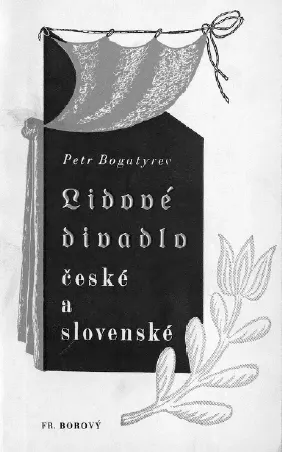
Fig. 3: Cover of Petr Bogatyrev’s Czech and Slovak Folk Theatre, 1940. The neo-classical design by František Muzika forms a contrast to the Modernist design of Slovo a slovesnost. The traditional appearance is due to motifs such as the stylised flower, common in folk design, the improvised theatre curtain (even though the folk theatre productions discussed by Bogatyrev very rarely used any kind of curtain) and the use of Gothic script. At the time the book was published, Bogatyrev had already left Prague and returned to Moscow.
When Honzl wrote his renowned “The Mobility of the Theatrical Sign” (1940) and presented it as a lecture in the PLC series, he had already had a successful and rich career in the arts. Not only had he contributed to the Devětsil (literally nine forces) movement, which created a new synergy for the avant-garde artists working in the spheres of the “Nine Muses” (art disciplines), but he had also established and was stage director of the era-defining avant-garde Liberated Theatre (Osvobozené divadlo) and had made three feature films – not to mention his other activities in leading theatres throughout the country and his publications on Soviet theatre. Honzl’s essay is written with an acute awareness of the practical theatre and with all his abundant experience with experimental performative forms. While Honzl’s legacy survives more in his theoretical and pedagogical work, despite his prolific activities as theatre director and occasionally as film director, the core of the work of his two companions and contemporaries, the directors E. F. Burian and Jiří Frejka, lay predominantly in innovative theatre practice, which was underpinned by theoretical reflections. All three of them were influenced by the Russian theatre avant-garde, in particular the work of Vsevolod Meyerhold and Alexander Tairov.
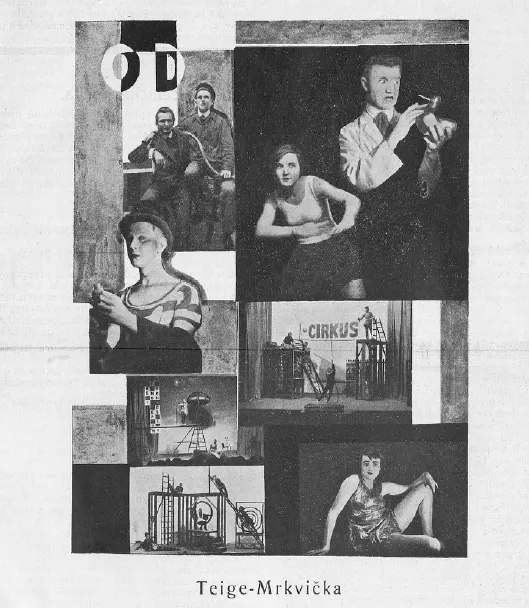
Fig. 4: Karel Teige and Otakar Mrkvička: “Liberated Theatre”, photomontage, 1926. An example of Teige’s Modernist typographical style. In includes photos from some of the Liberated Theatre’s early productions: Georges Ribemont-Dessaignes’s The Mute Canary, directed by Jindřich Honzl (top right and centre left); a reworked version of Molière’s Georges Dandin entitled Cirkus Dandin (The Dandin Circus), directed by Jiří Frejka (centre right); and Frejka’s adaptation of Aristophanes’ comedy The Women Celebrating the Thesmophoria (bottom left).
Burian came to the theatre as an accomplished and acclaimed composer and musician and his authorial style, developed fully in his Theatre D, bore witness to this artistic background. In his programme of the theatre of synthesis (syntetické divadlo), he undermined the established relations between individual components of the art form and approached them in a dynamic way. The organizing principle of the theatre was the inherent musicality of movement, space, sounds and words. Rather than imposing a musical logic onto the form, Burian developed the elements present in the material itself. Jan Mukařovský identified this feature in an essay for an almanach of Burian’s Theatre D and contextualized it with the operatic experiments of Leoš Janáček (1854–1928):
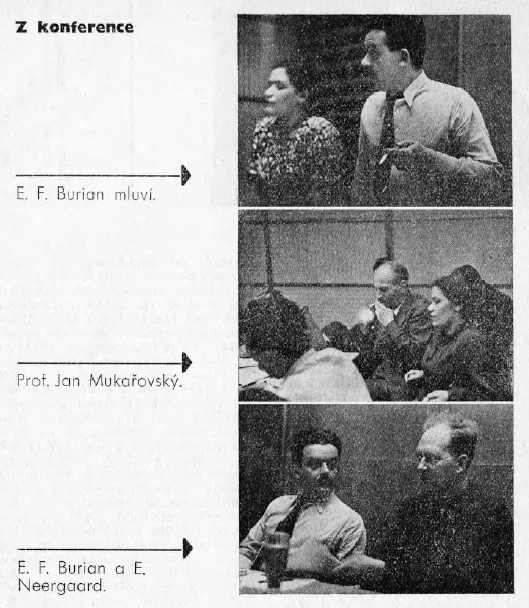
Fig. 5: Jan Mukařovský (with E. F. Burian on the left, in white shirt) at an international conference on the avant-garde theatre organized by Theatre D i...
Table of contents
- Cover Page
- Copyright
- Table of Contents
- List of Figures
- Acknowledgments
- Introduction by David Drozd and Tomáš Kačer
- Editors’ Choices and Guidelines
- I Theatre in General
- II Sign – Object – Action
- III Figures and Play
- IV From Page to Stage
- V Layers of Space
- VI Towards Structures of Modern Acting
- VII Ethnographic Encroachments
- VIII Art – Media – Society
- Prague School Theatre Theory and Its Contexts (Afterword) by Pavel Drábek (with Martin Bernátek, Andrea Jochmanová and Eva Šlaisová)
- Biographies of Authors Presented in the Reader